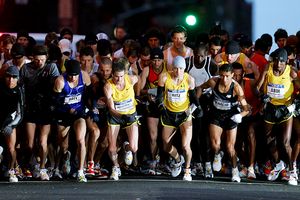
ESPN’s True Hoop posted a very interesting article called: Being an Elite Athlete: “It Looks Like Peace, But It’s War”.
Author Henry Abbott makes a very interesting comparison between drafting an athlete in the NBA and the qualities that comprise successful Ethiopian marathon runner, Haile Gebrselassie.
Some of this article speaks to motivation, but it also rests on the issue of talent identification.
“Just about every top player faces punishment from opponents (some bigger, some stronger, some younger, some smarter), injuries, complicated relationships with coaches and teammates, family and friends competing for time and money, media pressure to be everything all the time, stretches when playing time is hard to come by, and all kinds of times when … you can’t show the world the best of what you can do.
Succeeding as an NBA player means dispensing with these obstacles one way or another. Getting stuck on any one of them, in such a competitive environment, only creates opportunities for others to pass you by.”
Abbott argues that judging an NBA prospect based on a morning workout is “like picking who’s going to win a marathon based on watching people line up at the starting line. It’s some information. But not much.” He’s right about that. It does need to be said that there’s a heck of a lot more that goes into draft decisions that any one or two workouts.
NBA prospects are being ID’d and scouted for years. And, well prior to NBA Draft Day, extensive research is being done beyond the obvious in-game qualities (e.g. psychological testing, police background checks, private investigators, family background assessments, interviews with former coaches/friends/teammates, etc.). I heard recently that the San Antonio Spurs have a three-pronged “EYES, EARS, NUMBERS” approach:
- Eyes = In-person and video scouting of players to see who can play.
- Ears = They evaluate friends, parents, and even grandparents to get a long-term trend on a player’s behaviours.
- Numbers = Deep dive and analysis of the basketball statistics.
At the end of the day, having been on that side of professional basketball, there are very few stones left unturned – especially if you’re being projected as an NBA lottery pick.
Granted with all that intel it’s still not an exact science. I’d side with the author on that one for sure. As one long-time NBA scout said to me: ‘Trying to ID a top pick is like trying to find a black cat in a dark room.’
Abbot suggests that NBA General Managers should seek out players with the mentality of Gebrsellasie. Those, that is, with the drive to “own the race even at its toughest moments, after a thousand challenges – you’d probably do well, no matter how high he can jump, or how long his arms are.”
If you get to the bottom of the article, there’s a very astute point of differentiation between individual and team sport achievement. He says: “That ‘certain something’ the runner from Ethiopia has is not quite what an NBA champion needs. He does need it, but he must be able to manifest it within a team framework; leading at times, but following at other times. Yet, still hungry for the fight every step of the way. Runners only need to inspire themselves, but ballers need to carry their team with them while allowing themselves to be carried sometimes as well.”
You Don’t Have The Luxury Of Minding Their Own Business
The achievement of excellence in team sport means that athletes, individually and collectively, don’t have the right to mind your own business. Having the approach of Gebrsellasie is an expectation of any individual who aspires to achieve at a world class level. Leadership and influence in a team environment, though, requires a lot of extras.
- Not just a sustained ‘best’ effort during difficult situation for the individual leader, but also the ability of that leader to sustain their effort while also inspiring teammates to do the same.
- More than a vision for oneself, but the ability to enroll others in that vision.
- Beyond having a clear focus individually, but getting careless players to focus and distracted players to pay attention.
The dynamics of leadership in team sport are quite different from individual sports. Not only must you win the internal ‘arguments with self,’ but must also be able to do the same in others. The question in talent evaluation then becomes: Can they positively influence the direction of the group? There are so many elements involved in the answer to that equation. Makes it really tough to predict.
And, it’ll be very interesting to see how GMs make their picks this year.
—sef.
Clyde “The Glide” Drexler, the man who is revered for jaw-dropping dunks and superb athleticism said it was intelligence and mental strength that separated him from his peers… “The ability to bounce back and rationalize and move past anything that has happened to you is big in professional sports. You have to have complete confidence, short memory, resiliency and an undying will. That was me in a nutshell – forever attacking, forever trying, forever giving everything you had and being willing to live with the results while at the same time having fun and respecting the competition. I may have had a 44-inch vertical (leap) and ran a 4.2 (second) 40-yard dash. I may have big ‘ol hands that could palm the ball off a dribble, but those things are only part of the game. You have to think the game.”